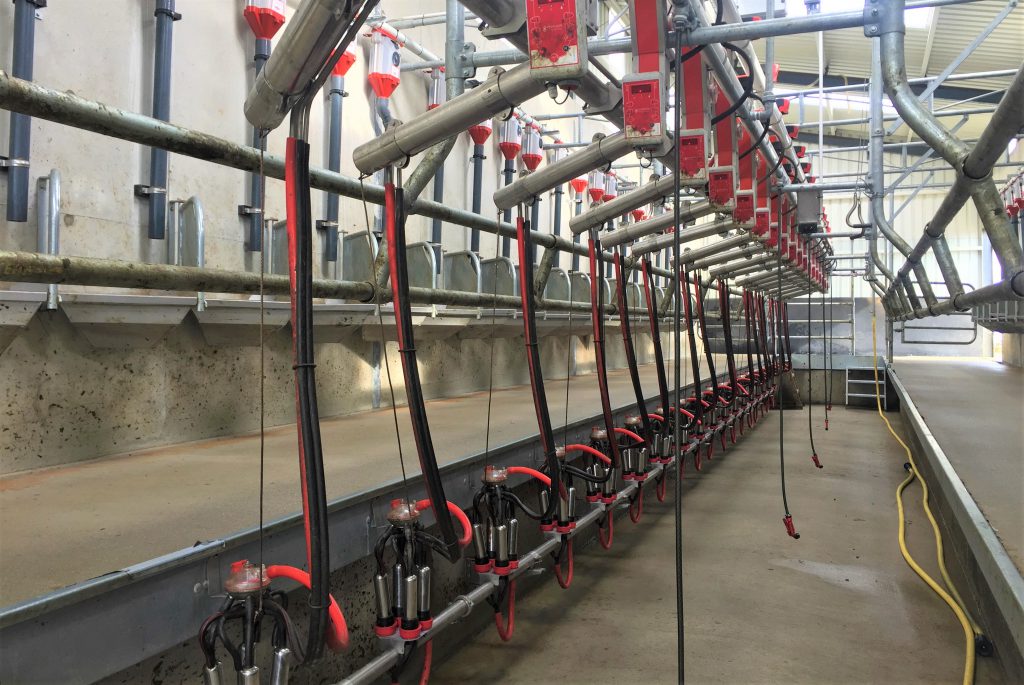Francis Quigley, a Teagasc milking machine specialist, outlines what farmers should consider when upgrading a milking parlour.
Francis stated: ”Farmers should assess their current milking facility. Look at the structure and roof to see if they are in good condition.
”The ceilings may be low; there may be a loft overhead. Is the shed dark?
”This will be unattractive to cows, and they will be slower to move from the collecting yard into the parlour, forcing the milker out of the pit more often,” he continued.
“Farmers should check the pit’s depth. A shallow pit will mean the milker has to stoop [and] this will cause back injury over time.
”Many older parlours have a fall on the cow stand, running in the opposite direction to the fall on the milk line.
”You can get away with this on a short parlour, but this is not acceptable in a longer parlour as the height of milk lift from each cluster will be different, which will result in different vacuum levels in the claw bowl as you move back the parlour.
”Also, incorrect slopes or dips in the milk line can cause a range of issues, including increased mastitis, raised cell count, and poor hygiene due to drainage issues.”
Number of units to install
The number of units a farmer requires depends on the size of the herd. Francis commented: “The aim is to be milking between seven and nine rows of cows; this will ensure a milking time of no more than one hour and 30 minutes.
”For a 100-cow herd, a 14-unit parlour will have just over seven rows of cows to be milked. Individual row time will be affected by the pre-milking routine and the stage of lactation.
”An operator can handle 14-units where cows are prepared (cleaning/stripping milk). Where no preparation takes place, an operator can handle up to 22 cows.”

Herringbone versus side-by-side
Choice of parlour will often come down to a farmer’s personal preference. It is recommended to visit several different farms to see the various systems before choosing one.
Francis stated: ”Ideally, try milking in the different parlours to see which best suits you.
”In a side-by-side parlour, cows are right-angled to the pit and clusters are applied between cows’ legs.
“They are normally installed with a sequential baling system; this can add to the initial cost and the ongoing maintenance with the parlour.
”A popular option is the 762mm herringbone; cows are at 500 angles to the pit,” he added.
”The cows are further apart thaN with side-by-side, but the cluster stills go on between the back legs of the cow.
”No matter which system you opt for, it is very important to check the dimension required as the parlour length and width will vary.
”If it is wrong, it can be hard / expensive to fix. The machine manufacturer will give you the recommended construction dimensions for their parlour.”

Location factors
Location is the most important factor when considering a milking parlour. Francis added: ”The parlour needs to be located so that there is good cow flow from the paddocks and the cubicles.
“You need to avoid sharp corners and U-turns. The access route for the milk lorry needs to be separate from any cow roadways. This is to minimise any contamination of the milk lorry with dung.
”Also, consider the prevailing wind direction; the parlour should be downwind of the dwelling house and upwind of other livestock sheds,” he added.
”Also, shelter may be needed to prevent harsh winds from blowing into the milking parlour, making it an unpleasant work environment.”
Budget
The budgetary requirements of a new milking parlour will vary depending on individual circumstances.
Francis stated: ”There are so many factors that can influence costs. Can existing buildings be used?
”Do you need additional dirty water storage? Is the existing ESB power supply adequate?
“The specification of the milking equipment will have a big influence on the overall budget.
”A very basic machine without feeders, and maybe with some preowned parts from the old machine, might start at around €2,000 per unit,” he continued.
”A top-spec machine with swing arms; ACRs (automatic cluster removers); automatic front and rear gates; diversion line; electronic milk metres; electronic feeders; automatic identification; auto washer; and electronic drafting, could be around €8,500 per unit.
“It is preferable to focus on getting the correct number of units over a greater level of automation.
”If you opt for a high level of automation, is it imperative to ensure that all milkers, including relief staff, are well trained on the equipment’s correct operation.”

Final words of advice
”Farmers should avoid budget creep when upgrading a milking parlour”, he stated.
“Carefully plan what you want to do, get your planning permission, and get several quotations for each element of building the parlour; dairy and collecting yard; the milking machine; the bulk tank; electrical; and plumbing.
”When comparing quotations, ensure that you are comparing like-with-like.
”Remember, the more automation you add, the more maintenance costs will be involved in running and servicing.
”It is worth asking about these costs in advance – how much is it to fit a service kit to a milk metre and how often is it required,” he concluded.
